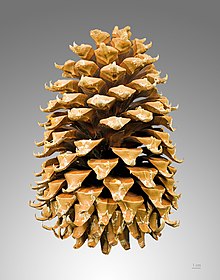Our website is made possible by displaying online advertisements to our visitors.
Please consider supporting us by disabling your ad blocker.
Conifer cone



A conifer cone, or in formal botanical usage a strobilus, pl.: strobili, is a seed-bearing organ on gymnosperm plants, especially in conifers and cycads. They are usually woody and variously conic, cylindrical, ovoid, to globular, and have scales and bracts arranged around a central axis, but can be fleshy and berry-like. The cone of Pinophyta (conifer clade) contains the reproductive structures. The woody cone is the female cone, which produces seeds. The male cone, which produces pollen, is usually ephemeral and much less conspicuous even at full maturity. The name "cone" derives from Greek konos (pine cone), which also gave name to the geometric cone. The individual plates of a cone are known as scales. In conifers where the cone develops over more than one year (such as pines), the first year's growth of a seed scale on the cone, showing up as a protuberance at the end of the two-year-old scale, is called an umbo, while the second year's growth is called the apophysis.[1]
The male cone (microstrobilus or pollen cone) is structurally similar across all conifers, differing only in small ways (mostly in scale arrangement) from species to species. Extending out from a central axis are microsporophylls (modified leaves). Under each microsporophyll is one or several microsporangia (pollen sacs).
The female cone (megastrobilus, seed cone, or ovulate cone) contains ovules which when fertilized by pollen become seeds. The female cone structure varies more markedly between the different conifer families and is often crucial for the identification of many species of conifers.
- ^ Rushforth, Keith (1987-01-01). Conifers. London: Christopher Helm Publishers. pp. 221–223. ISBN 0-7470-2801-X.
Previous Page Next Page


